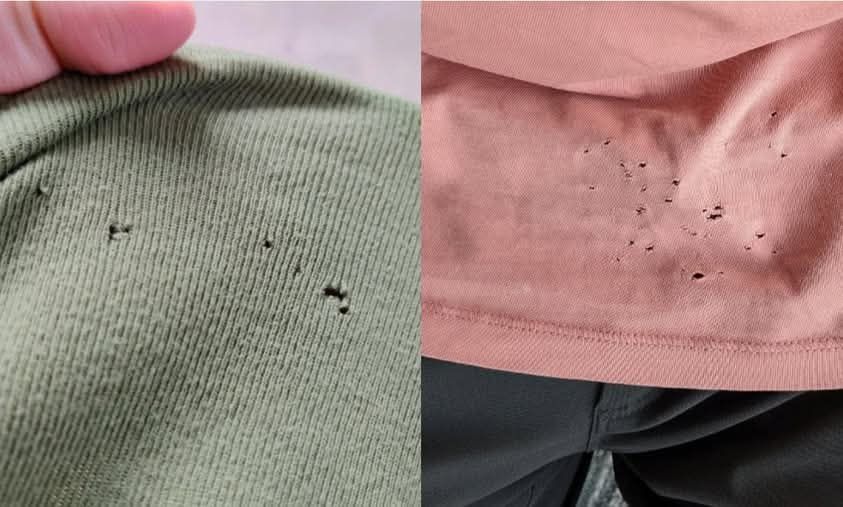ADVERTISEMENT
### **The Mystery of Tiny Holes in T-Shirts: A Common Problem**
When you first notice a small hole in your T-shirt, you might dismiss it as a fluke. But then, you find another one—and then another. It’s an annoying pattern that many people experience, and it doesn’t seem to matter how expensive or inexpensive the T-shirt is. Whether it’s a casual tee or a designer item, tiny holes are an equal-opportunity nuisance. But why does this happen? Why do these holes appear, seemingly out of nowhere, in places like the stomach, chest, or along the seams?
The short answer is that there are several reasons why tiny holes can form in T-shirts. From poor-quality fabric to improper washing techniques, the causes are varied. However, by understanding these causes, you can make informed decisions about how to extend the life of your clothing and prevent the same problem from happening again. Below, we’ll break down the primary causes of these tiny holes, their specific symptoms, and what you can do to avoid them.
—
### **1. Friction from Seat Belts or Bags**
One of the most common causes of tiny holes in T-shirts is friction. This type of wear and tear often occurs from regular daily activities. Two of the biggest culprits are **seat belts** and **bags**.
#### **Seat Belt Friction**
Many people don’t realize it, but the seat belt in your car is a constant source of friction on your clothing, especially in areas where the seat belt crosses your body. As you get in and out of your car, the seat belt rubs against your T-shirt, often in the same spot over and over. This repetitive friction weakens the fabric, causing tiny holes to form in vulnerable areas, particularly around the waist or near the chest.
#### **Bag Straps and Handles**
If you carry a shoulder bag, backpack, or tote bag, the straps can create friction on the fabric of your T-shirt, particularly at the shoulder or near the underarm area. As the bag rubs against the shirt fabric over time, it causes the fibers to break down, leading to small holes.
**Solution**: While it’s not realistic to stop wearing seat belts or carrying bags, there are a few things you can do to minimize the damage. For seat belts, try wearing a jacket or hoodie over your T-shirt to reduce friction, or consider placing a piece of fabric or padding between your T-shirt and the seat belt. For bags, ensure that your bag is properly fitted, and consider switching the side you wear it on from time to time to avoid creating wear patterns in the same spot.
—
### **2. Fabric Quality and Wear**
The quality of the fabric plays a significant role in how susceptible your T-shirt is to developing holes. Cheap or poorly made fabrics are more prone to breakdown, even under normal wear. Thin, lightweight fabrics, in particular, may be more prone to snagging, stretching, and tearing over time. This is often the case with mass-produced, budget-friendly T-shirts, which are usually made from a lower-quality cotton blend.
#### **Low-Quality Fabrics**
T-shirts made from low-quality cotton or synthetic blends are more likely to develop holes after repeated washing and wearing. The fibers in lower-quality fabrics are often not as tightly woven, making them more vulnerable to damage. In some cases, the cheap dyes used in the fabric can also contribute to the degradation of the fibers, causing them to weaken over time.
#### **Fabric Softener Damage**
Another hidden culprit of fabric breakdown is the overuse of fabric softeners. While fabric softeners can make clothes feel soft, they also contain chemicals that can coat the fibers, making them weaker and more susceptible to damage. Over time, this buildup can cause T-shirts to develop tiny holes, especially in areas that are prone to friction.
**Solution**: Invest in high-quality T-shirts made from premium materials, such as 100% cotton or organic cotton blends, as these fabrics tend to hold up better over time. Additionally, use fabric softeners sparingly, or opt for more natural alternatives like white vinegar or baking soda.
—
### **3. Laundry Mishaps: Zippers, Velcro, and Overloading the Machine**
Another major culprit behind tiny holes in T-shirts is laundry mishaps. Our laundry habits, from overloading the washing machine to improperly separating clothes, can lead to fabric damage that results in small holes.
#### **Zippers and Velcro**
One of the most common laundry culprits is **zippers** on other clothing items, such as jackets, jeans, or hoodies. Zippers can easily snag on your T-shirt during washing or drying, creating small holes in the fabric. Similarly, **Velcro** on jackets or bags can also be a source of damage when it rubs against your clothes.
**Overloading the Washing Machine**
If you tend to overload your washing machine, clothes are more likely to rub together in an abrasive way. This constant friction can cause fabric to weaken, especially in delicate areas like the armpits, necklines, or waistbands. When fabrics rub together too much, they can develop tiny holes.
For Complete Cooking STEPS Please Head On Over To Next Page Or Open button (>) and don’t forget to SHARE with your Facebook friends
